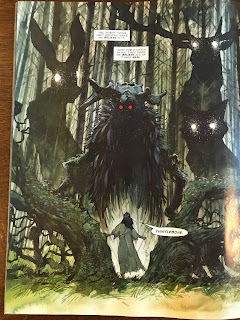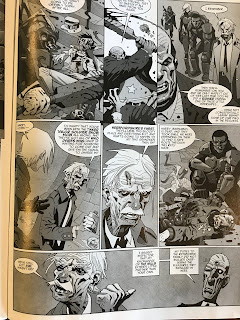As I write about some of my favorite things here, over and over again I find myself feeling as if they were created just for me. I guess I feel lucky that I can find so many comics, books, movies, TV shows, and more to enjoy and talk about, rather than complaining about not being able to find any. (Seeing complaints like that was the impetus for creating this blog, after all.) A favorite book series of mine is Newbury and Hobbes, by George Mann, which feels as if he went into my head, picked out some of my favorite things, and put them altogether into one steampunk-y stew. I don’t talk a lot about books here, because they're not very visual. However, since Titan Comics has just published the collection of Mann’s (hopefully first) Newbury and Hobbes comic book miniseries, so now I can finally showcase it.
I call the series “steampunk-y” because, honestly, I’m not sure what constitutes modern steampunk any more. When I was a kid, I read the foundational works of the genre: Infernal Devices by KW Jeter, Anubis Gates by Tim Powers, and Homunculus by James Blaylock. I still read those authors, but I feel like steampunk has grown into a bigger multimedia aesthetic and genre that now means something way beyond those authors’ weird Victorian fantasies. (Some time ago, I read a review of one of Blaylock’s Langdon St Ives novels, a series begun with the aforementioned Homunculus, and the author bemoaned that it didn’t really fit their definition of steampunk. Sigh.)
Personally, regardless of narrow genre definitions, the Newbury and Hobbes books are great. According to Mann, the influences include the Avengers (the Steed & Mrs Peel version, not the Marvel superheroes), Sherlock Holmes, Doctor Who, and Hammer Horror, among others. In fact, Mann has even written novels and audio stories crossing the Newbury and Hobbes world with Sherlock Holmes and Doctor Who. He’s also written a spin-off series with more of a pulp hero sensibility, set in New York in the 1920s, featuring a character called The Ghost.
I love all those things, so it makes sense that I love this series. Most importantly for any series, it’s got a couple of likable characters in the lead, namely Sir Maurice Newbury and Veronica Hobbes. Newbury is a secret agent working for the Crown, which is still being worn by Queen Victoria. The books are set in the late 19th and early 20th century, and here Victoria is a harsh, ruthless ruler, bitter from the passing of her beloved Albert and kept alive by steam-powered life support equipment. She’s a pretty horrific character in the novels, and her depiction in the comics pretty much exactly captures that feel.
For his part, Newbury isn’t a typical pure hero. He’s smart and capable, as adept at physical action as he is as an intellectual. But, like Sherlock Holmes and John Steed, he’s a bit arrogant. (Also like Steed, he can be a bit thick at times, but also charming.) He has to be rescued by Veronica at least as often as he saves her. Also, he’s a laudanum addict, and frequently has to be pulled out of a drug den at the start of a new adventure.
In a lot of ways, the series’ central character is Veronica Hobbes. Much like Emma Peel, she is the one who spots the important clues and puts the pieces together. She also protects and defends Newbury, and helps smooth over the rough spots when he has trouble dealing with people. Perhaps most importantly—for Newbury—she keeps him focused and on track when his addictions threaten to lure him away.
The third main character is Sir Charles Bainbridge, chief inspector of Scotland Yard, and close friend of Newbury’s. His salt of the earth nature helps keep a lot of the weirdness grounded and relatable.
And such weirdness there is! In addition to the aforementioned steam-powered Queen Victoria, there are mad scientists, clockwork mechanical soldiers and horses, plagues that turn people into undead zombie-like revenants, weird cults, and so much more. It’s a rich, complex brew of strangeness and mystery. And the real magic is in the way Mann brings all these elements together into a cohesive, consistent whole. I don’t want to say it’s easy to write a story set in a historical world, but at least it can be kept consistent with thorough enough research. It’s also easy to throw weird fantasy elements into a world for the sake of weirdness. What isn’t anywhere near so easy is to combine the weird strange things with the historical stuff, and have it all fit together into a believable world without losing the sense of the odd or wonder. And that’s exactly what Mann has done in this series.
Of course, no matter how believable the setting (or how weird and compelling), a series isn’t worth coming back to again and again if it isn’t peopled with characters we care about, who grow and change and develop from book to book. Here, we see a definite progression, whether it’s Newbury’s relationship with Hobbes, developments with Veronica’s sister from book to book, ongoing mysteries featuring Bainbridge and the Secret Service, Veronica’s concerns about Newbury’s addictions, and so forth. A good story keeps you entertained. Great characters make you want to keep coming back for the next one.
So far, there are five novels in the series, plus a collection of short stories and one graphic novel. Having read the series as it was published, it’s hard for me to judge how accessible the graphic novel is for new readers. It does take place after the fifth novel, and features a number of references to earlier books. I feel like it also explains those references enough for a new reader to appreciate this story, without having those earlier stories completely spoiled. But, as I say, I’m not coming to this story as a new reader, so I am not the best judge.
One benefit the comic certainly brings to the series is the art by Dan Boultwood. I’m pretty sure I first saw his art in the pages of the children’s anthology comic The DFC, maybe on an Arabian-Knights-inspired strip written by Tony Lee? Regardless, when I heard he was working on a Newbury & Hobbes comic, I felt he was an ideal choice.
Boultwood’s art has a distinct, stylized look. While not as detailed or influenced by classic illustration as Bret Blevins and John Ridgway (the artists on The Bozz Chronicles, the other weird Victorian comic I have talked about on this blog), he shares their ability to integrate the strange elements in with the real world. That’s as important here as Mann’s ability to create that world in the first place.
There are any number of ways to sample Newbury and Hobbes. There’s the first novel, of course, the comic, or the short story collection. For that matter, the collection of the comic book has a prose short story included. There’s also Mann’s Sherlock Holmes and Doctor Who novels, if you want to sample the characters in the company of perhaps better-known figures. My wife’s introduction to the characters was through The Decemberist, a self-published novella made up of 31 vignettes of 100 words each, one for each day of December. I read them to my wife, one each night; when she was on a trip to visit her parents for Christmas, I read those installments to her via FaceTime. Now she wants to hear more.
Newbury and Hobbes is influenced by so many things, but they way in which they come together is very much its own thing. And that thing is very enjoyable. I hope it runs for a long, long time.
This week, I thought I’d add a new feature to the blog. I’m a huge fan of the British weekly comic 2000 AD, featuring Judge Dredd. I’ve loved the stories and characters I was able to find in reprints since I was a kid. In 2002, I was overjoyed to learn I could actually subscribe to the comic and have it delivered weekly, so I have been subscribing ever since.
I have to admit, there were times I lapsed in reading it. Most recently, in 2016, I drifted away from it for a few years. I will be honest: then-current events made reading a satirical series about a future America run by fascists a lot less fun than it had been. Maybe a year or so ago, I decided to jump back onto the book, just starting with the then-current issues. I’ve been keeping up since then, and I’ll work on getting caught up on the stuff I missed when and as I can. So I thought every post, I would highlight something from the current issues of 2000 AD.
(Please excuse the plain old photos of the pages; I need to replace my scanner, but haven’t yet.)
Prog (or issue) 2135 introduces a new folk horror series, Thistlebone. The comic has featured horror strips in the past, but not too often, so this is a nice change from the usual sci fi and fantasy. It’s written by TC Eglington, who is a relatively new writer to the comic. (When I say “relatively new,” I guess I mean he has started writing for them since I started reading; even though I’ve been getting the comic for over 15 years, I still see myself as a new reader.) The story features Avril Eason, a young woman who, as a child, escaped from a cult planning on sacrificing her to their god, Thistlebone. Accompanied by journalist Seema Chaudry, the now-adult Avril returns to the former home of the cult to confront her demons.
It’s a great start to a quiet, creepy, atmospheric story. One of the big draws for me is that it’s painted by Simon Davis, one of my favorite 2000 AD artists. Davis’s style is distinct and his own. It’s not as photorealistic as someone like Alex Ross, and not quite as impressionistic as someone like Bill Sienkiewicz. Davis’s art has graced such diverse series as the adventures of hit men of the future, Sinister/Dexter, PG Wodehouse meets HP Lovecraft series Ampney Crucis, the tales of Celtic barbarian warrior Slaine, and Judge Dredd himself. Here, he really seems to be enjoying painting the natural world, and these pages are beautiful.
Prog 2136 brings the first chapter of the final Absalom story (or so we are told), another horror series. Where Thistlebone is quiet and atmospheric, Absalom—which is about a team of British agents led by hard-as-nails, dying-of-cancer cop Harry Absalom—is loud and explodey. The horrors here aren’t lurking quietly in the shadows; they’re bursting out of the panels trying to rip our heroes to pieces.
The first couple of Absalom stories have been reprinted in books, which I’ve read. I’m not sure I’ve read the first part of this story; this installment is called Terminal Diagnosis Book 2. I don’t feel incredibly lost, though. We are in the home stretch, with Harry and his team working to rescue Harry’s grandkids from the demons who have held them hostage for years, before his cancer takes him. Judging from this first installment, it’s not going to be easy or clean. Gordon Rennie and Tiernen Trevallion have been doing great work on this series.
On the one hand, it’ll be sad to see it end. On the other hand, one of the things I like about 2000 AD is that—with the exception of lead strip Judge Dredd, which is in every issue—there’s not really a single strip or character that carries the comic. So stories can be carried out to their logical conclusions, rather than extended indefinitely for sales reasons. So unlike, for example, the John Constantine has cancer story in Hellblazer, where you could assume the main character of the book wouldn’t die as long as it was selling, Rennie and Trevallion can actually kill off Harry and end the series. And 2000 AD will keep on rolling every week, and we’ll have a nice complete set of Absalom collections, telling the story from beginning to end.
Also, here’s a reminder to check out and hopefully back the Trekker Kickstarter and the Impossible Jones Kickstarter.
And that’s it for this week. See you in two weeks!






























No comments:
Post a Comment